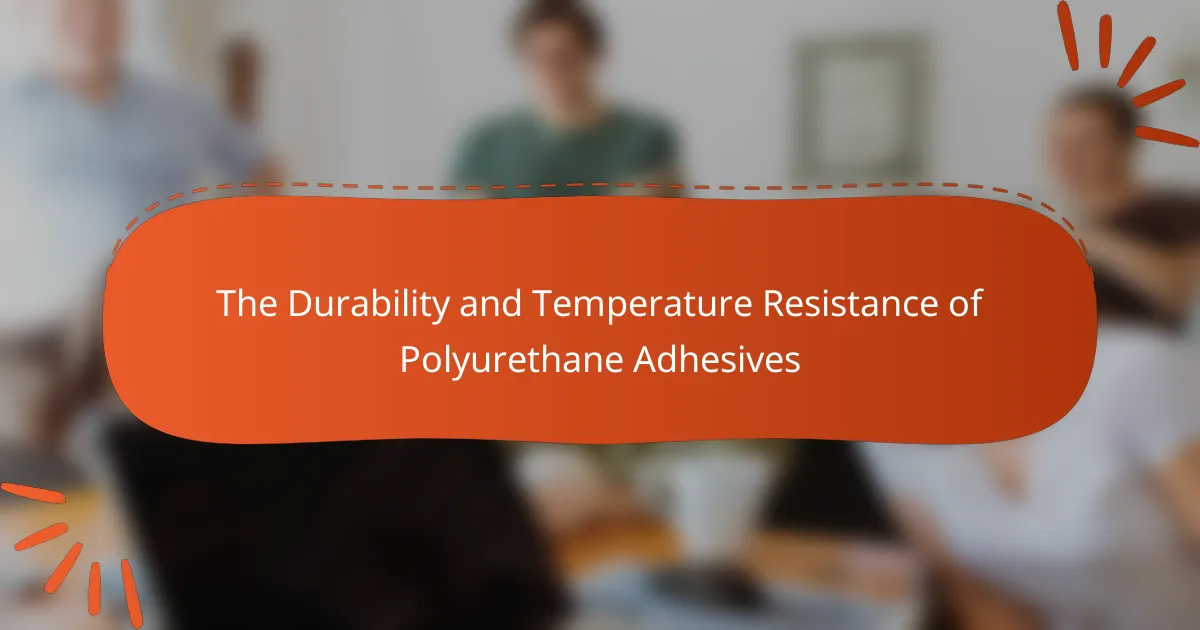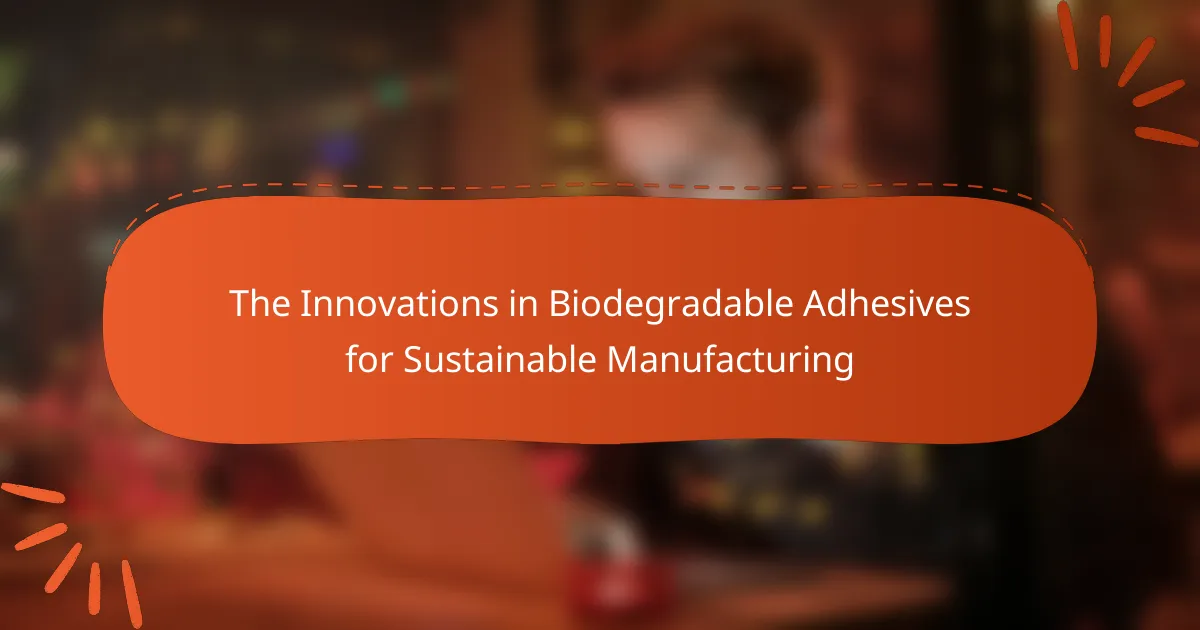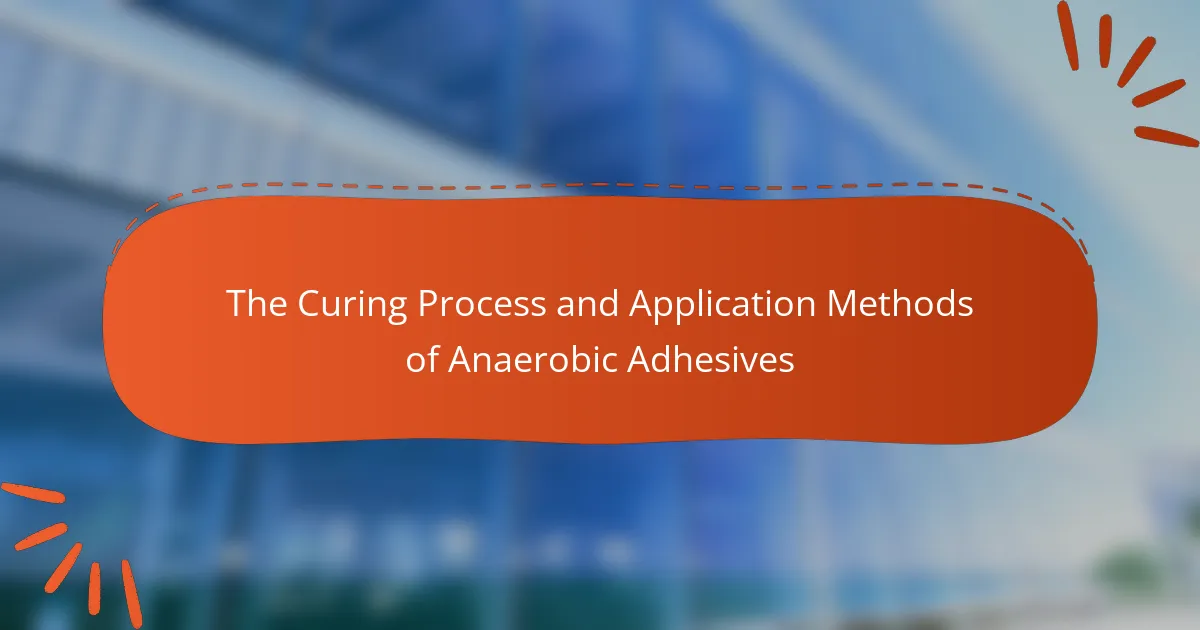Polyurethane adhesives are advanced bonding agents characterized by their polymer composition with urethane links. Known for their strong adhesion to diverse substrates such as wood, metal, and plastics, these adhesives offer flexibility, moisture resistance, and durability, making them suitable for various applications. Proper surface preparation, moisture control, and adherence to application temperature are crucial for optimal performance. Future developments in polyurethane adhesives are expected to enhance durability and temperature resistance, with a focus on bio-based alternatives and innovative curing technologies. This article explores the key features, application considerations, and potential advancements in the field of polyurethane adhesives.
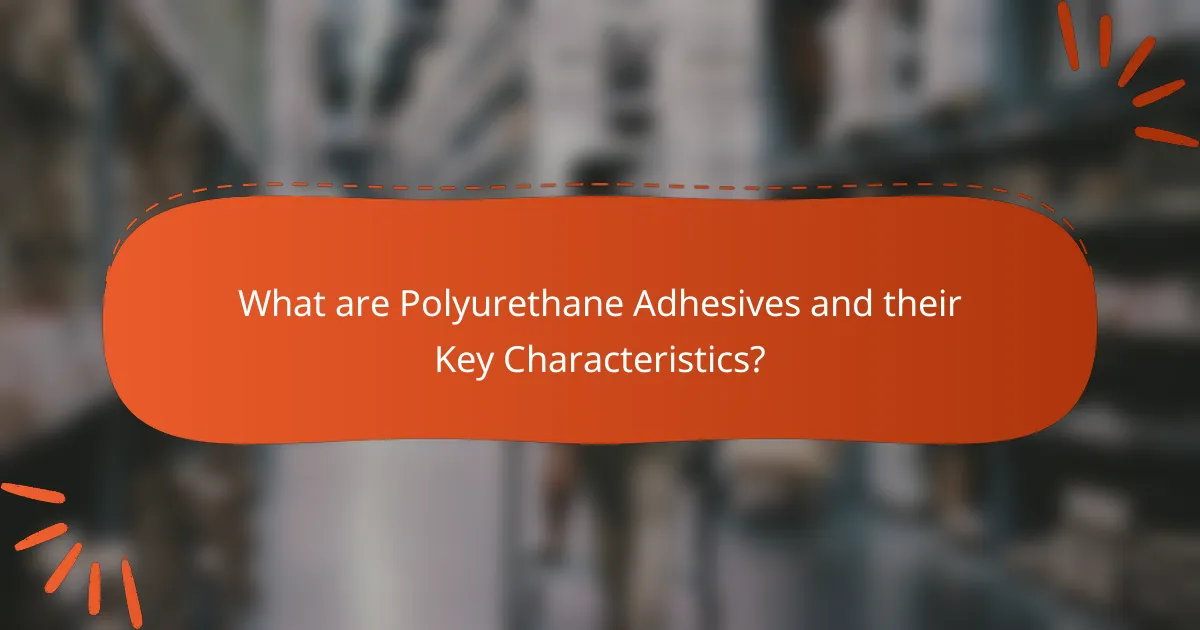
What are Polyurethane Adhesives and their Key Characteristics?
Polyurethane adhesives are versatile bonding agents made from polymers that contain urethane links. They are known for their strong adhesion to various substrates, including wood, metal, and plastics. Key characteristics include flexibility, which allows them to accommodate movement in bonded materials. They also exhibit excellent resistance to moisture, chemicals, and temperature fluctuations. Polyurethane adhesives can cure at room temperature or with heat, enhancing their versatility. Their durability makes them suitable for both indoor and outdoor applications. Additionally, they provide a strong bond that can withstand dynamic loads and stress.
How do Polyurethane Adhesives differ from other adhesive types?
Polyurethane adhesives differ from other adhesive types primarily in their flexibility and durability. They offer superior bonding strength across a variety of materials, including wood, metal, and plastics. Polyurethane adhesives are moisture-resistant, making them suitable for both indoor and outdoor applications. Unlike epoxy or cyanoacrylate adhesives, they can withstand extreme temperatures and fluctuations without losing adhesion. This unique property allows them to maintain structural integrity in challenging environments. Additionally, polyurethane adhesives often cure to a flexible bond, which helps absorb shock and vibration. Their versatility and resilience make them a preferred choice in construction and automotive industries.
What are the chemical properties of Polyurethane Adhesives?
Polyurethane adhesives exhibit several key chemical properties. They are formed through the reaction of polyols and isocyanates. This reaction creates a polymer network that provides excellent adhesion. Polyurethane adhesives are known for their flexibility and elasticity. They can withstand a wide range of temperatures, typically from -40°C to 90°C. These adhesives also demonstrate strong resistance to moisture and chemicals. Additionally, they have good tensile strength and impact resistance. Their chemical structure allows for curing through moisture, which aids in bond formation.
What are the physical properties of Polyurethane Adhesives?
Polyurethane adhesives exhibit several key physical properties. They are known for their strong bonding capabilities. These adhesives provide high tensile strength, allowing them to withstand significant force. They also have excellent elasticity, enabling them to absorb shock and stress without breaking. Polyurethane adhesives exhibit good resistance to moisture and chemicals. They can maintain their properties over a wide temperature range, typically from -40°C to 80°C. Additionally, they cure to form a flexible yet durable bond. Their versatility allows them to bond various materials, including wood, metal, and plastics.
What factors contribute to the durability of Polyurethane Adhesives?
The durability of polyurethane adhesives is influenced by several key factors. These factors include chemical composition, moisture resistance, and temperature stability. The chemical composition determines the adhesive’s bonding strength and flexibility. Moisture resistance protects the adhesive from degradation in humid conditions. Temperature stability ensures that the adhesive maintains its properties across a range of temperatures. Additionally, the curing process affects the final strength and durability of the adhesive. Proper curing leads to optimal cross-linking, enhancing durability. Studies indicate that adhesives with higher molecular weight polymers exhibit improved durability.
How does the formulation impact the durability of Polyurethane Adhesives?
The formulation significantly impacts the durability of polyurethane adhesives. Different chemical compositions determine their resistance to environmental factors. For instance, the ratio of polyol to isocyanate affects the adhesive’s strength and flexibility. Higher polyol content generally enhances durability by improving elasticity. Additionally, the inclusion of additives can provide UV resistance and moisture stability. Research indicates that formulations designed for specific applications yield better long-term performance. For example, a study by Zhang et al. (2021) found that optimized formulations increased adhesion strength by up to 30% under stress conditions. Thus, careful formulation is crucial for maximizing durability in polyurethane adhesives.
What role does surface preparation play in adhesive durability?
Surface preparation is crucial for adhesive durability. Proper surface preparation enhances the adhesive’s bond strength. It removes contaminants such as dust, oil, and moisture. Clean surfaces promote better adhesion by increasing contact area. Roughening surfaces can also improve mechanical interlocking. Studies show that prepared surfaces can increase bond strength by up to 50%. Inadequate preparation can lead to premature failure. Therefore, effective surface preparation is essential for maximizing adhesive performance.
How do temperature variations affect Polyurethane Adhesives?
Temperature variations significantly impact polyurethane adhesives. High temperatures can accelerate curing time, leading to faster bond formation. However, excessive heat may also cause degradation of the adhesive, reducing its effectiveness. Conversely, low temperatures can slow down the curing process, resulting in weaker bonds. In extreme cold, the adhesive may not cure properly, leading to failure in adhesion. The optimal temperature range for most polyurethane adhesives is typically between 50°F and 90°F. Outside this range, performance can be compromised. Studies indicate that maintaining appropriate temperature conditions during application enhances the durability of the bond.
What is the temperature resistance range of Polyurethane Adhesives?
Polyurethane adhesives typically have a temperature resistance range of -40°F to 200°F (-40°C to 93°C). This range allows them to perform effectively in various environmental conditions. Some formulations can withstand even higher temperatures, reaching up to 300°F (149°C). This capability makes them suitable for applications in construction, automotive, and manufacturing industries. Their resistance to thermal degradation ensures longevity and reliability in bonding.
How do extreme temperatures influence the performance of Polyurethane Adhesives?
Extreme temperatures significantly affect the performance of polyurethane adhesives. High temperatures can cause these adhesives to soften and lose their bond strength. This reduction in strength may lead to adhesive failure in applications requiring structural integrity. Conversely, low temperatures can result in increased brittleness. This brittleness can make the adhesive more susceptible to cracking under stress. Research indicates that polyurethane adhesives perform optimally within a specified temperature range. For instance, many formulations maintain their properties between 20°C and 60°C. Outside this range, performance declines, impacting durability and longevity.
What are the practical applications of Polyurethane Adhesives in various industries?
Polyurethane adhesives are widely used across various industries due to their strong bonding properties and versatility. In the automotive industry, these adhesives bond components like windshields and body panels. They provide durability and resistance to temperature fluctuations. In construction, polyurethane adhesives are employed for bonding wood, concrete, and other materials. They enhance structural integrity and withstand environmental stress. The furniture industry utilizes these adhesives for assembling wooden products, ensuring longevity and stability. In the footwear sector, polyurethane adhesives bond various materials, offering flexibility and durability in shoe manufacturing. Additionally, the aerospace industry uses these adhesives for lightweight component assembly, contributing to fuel efficiency. Overall, polyurethane adhesives are essential in numerous applications, driven by their performance characteristics.
Which industries utilize Polyurethane Adhesives for their durability properties?
The automotive, construction, furniture, and aerospace industries utilize polyurethane adhesives for their durability properties. In the automotive sector, these adhesives bond components with high strength and resistance to environmental factors. The construction industry employs them for sealing and bonding materials, ensuring long-lasting structures. Furniture manufacturers use polyurethane adhesives for their ability to withstand stress and moisture. Aerospace applications benefit from these adhesives due to their lightweight and strong bonding capabilities. Each of these industries relies on the durability of polyurethane adhesives to enhance product performance and longevity.
How do temperature resistance features benefit specific applications?
Temperature resistance features in polyurethane adhesives enhance performance in extreme conditions. They allow these adhesives to maintain bond strength in high and low temperatures. This stability is crucial for applications in automotive, aerospace, and construction industries. For example, automotive adhesives must endure heat from engine components. Similarly, construction adhesives face temperature fluctuations in outdoor environments. Studies show that polyurethane adhesives can withstand temperatures ranging from -40°C to 120°C. This broad temperature range ensures reliability in diverse applications. Temperature resistance minimizes the risk of adhesive failure, ensuring safety and longevity.
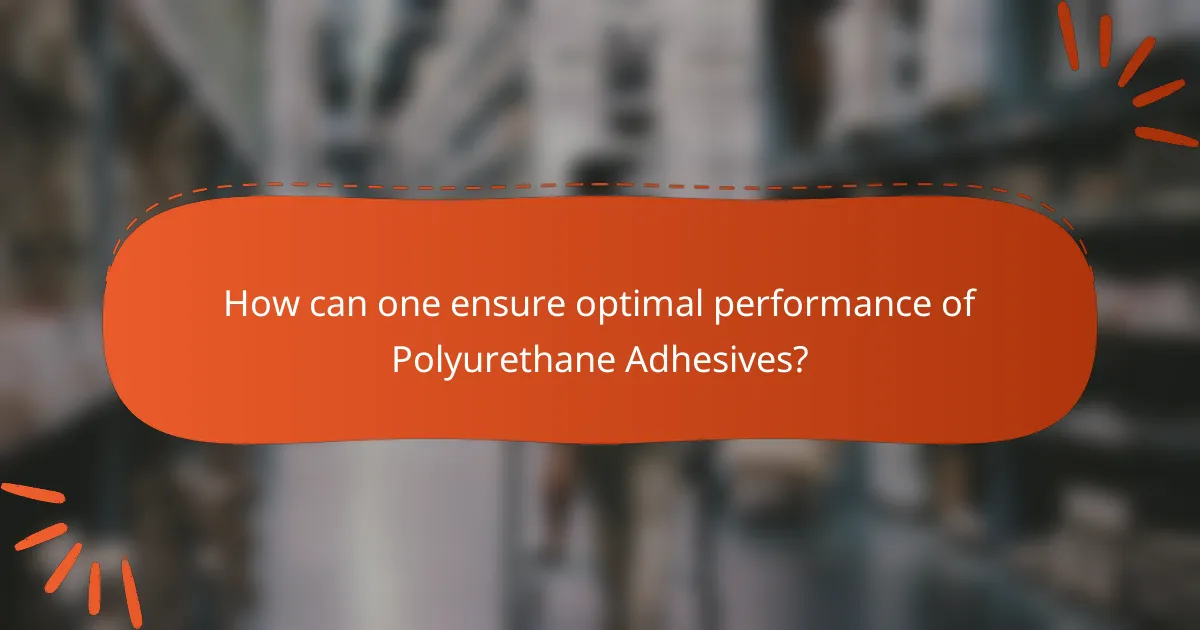
How can one ensure optimal performance of Polyurethane Adhesives?
To ensure optimal performance of polyurethane adhesives, proper surface preparation is essential. Clean surfaces remove contaminants that can hinder adhesion. Moisture control is also critical; adhesives perform best in dry conditions. The application temperature should be within the manufacturer’s recommended range, typically between 50°F and 90°F. Curing time must be adhered to, as insufficient time can weaken the bond. Additionally, using the right adhesive formulation for the specific materials improves performance. Testing adhesion strength before full application can help confirm effectiveness. These practices contribute to the durability and temperature resistance of polyurethane adhesives.
What best practices should be followed when using Polyurethane Adhesives?
Use polyurethane adhesives in a well-ventilated area. Adequate ventilation minimizes inhalation of fumes. Ensure surfaces are clean and dry before application. Clean surfaces enhance adhesive bonding. Apply adhesive evenly for optimal strength. Uneven application can lead to weak joints. Follow manufacturer’s instructions for curing time. Proper curing ensures maximum durability. Use appropriate personal protective equipment, such as gloves and goggles. This protects against skin and eye irritation. Store adhesives in a cool, dry place. Proper storage prolongs shelf life and effectiveness.
How can surface preparation enhance adhesive performance?
Surface preparation enhances adhesive performance by ensuring optimal bonding conditions. It removes contaminants such as dust, oil, and moisture. Clean surfaces allow adhesives to penetrate and form stronger bonds. Roughening surfaces increases the contact area for adhesion. This mechanical interlocking improves the overall strength of the bond. Studies show that proper surface preparation can increase bond strength by up to 50%. For polyurethane adhesives, effective surface preparation is crucial for achieving maximum durability and temperature resistance.
What environmental conditions should be considered during application?
Environmental conditions that should be considered during application include temperature, humidity, and surface cleanliness. Temperature affects the curing process of polyurethane adhesives. Ideally, the application temperature should be between 50°F and 100°F for optimal performance. High humidity can lead to improper curing and reduced bond strength. Surfaces must be clean and free of contaminants to ensure effective adhesion. Dust, oil, and moisture can compromise the bond. Additionally, ambient conditions can influence the working time of the adhesive. Monitoring these factors ensures the durability and effectiveness of the adhesive application.
What troubleshooting tips can help address common issues with Polyurethane Adhesives?
To address common issues with polyurethane adhesives, ensure proper surface preparation. Clean surfaces should be free from dust, grease, and moisture. Use a suitable primer if necessary to enhance adhesion. Verify that the adhesive is mixed correctly according to manufacturer instructions. Monitor the temperature and humidity levels during application. Polyurethane adhesives perform best within specific temperature ranges, typically between 60°F and 100°F. Allow adequate curing time before applying stress to the bond. If the adhesive does not cure, check for expired products or improper mixing ratios. For foaming issues, ensure proper moisture levels, as polyurethane adhesives require moisture to cure effectively.
How can one identify and resolve adhesive failure due to temperature extremes?
Adhesive failure due to temperature extremes can be identified through visual inspection and performance testing. Look for signs such as delamination, discoloration, or bubbling. These indicate that the adhesive bond has weakened. Performance testing can include peel tests or tensile strength assessments.
To resolve adhesive failure, first, remove the failed adhesive completely. Clean the surfaces to ensure they are free from contaminants. Select a polyurethane adhesive with a suitable temperature range for the application. Apply the adhesive according to the manufacturer’s instructions. Allow adequate curing time to achieve optimal bond strength.
Research shows that polyurethane adhesives can be effective in varying temperatures if selected properly. For instance, studies indicate that certain formulations maintain integrity in temperatures ranging from -40°F to 200°F.
What steps can be taken to improve adhesion in challenging conditions?
To improve adhesion in challenging conditions, surface preparation is essential. Cleaning surfaces removes contaminants that hinder bonding. Roughening surfaces increases the area for adhesion. Using primers can enhance the bond strength significantly. Selecting the right polyurethane adhesive for specific environmental conditions is crucial. Temperature and humidity can affect the curing process, so adjustments may be needed. Applying adhesives in optimal temperature ranges improves performance. Testing adhesion strength under various conditions ensures reliability. These steps are supported by research indicating that proper surface preparation and adhesive selection lead to better adhesion results.
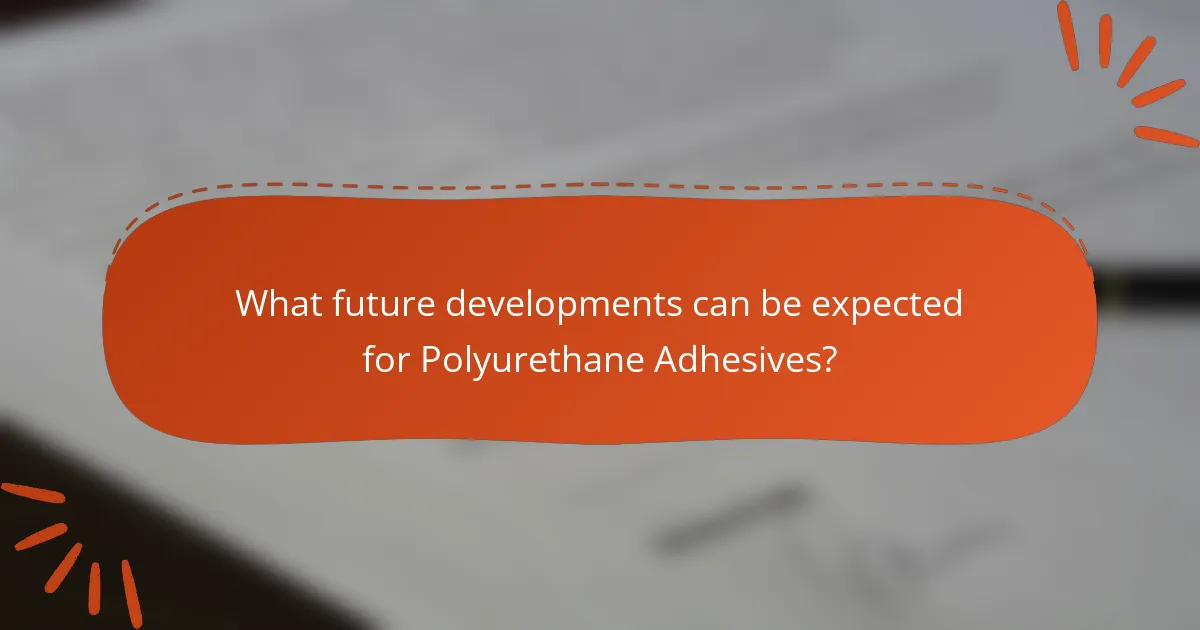
What future developments can be expected for Polyurethane Adhesives?
Future developments for polyurethane adhesives include enhanced durability and temperature resistance. Manufacturers are focusing on formulating adhesives that withstand extreme conditions. Innovations in chemical formulations will likely lead to improved bonding strength. Research indicates that bio-based polyurethane adhesives may gain traction. These alternatives offer environmental benefits alongside performance enhancements. Advances in curing technologies are expected to reduce application times. Additionally, smart adhesive systems could emerge, allowing for real-time monitoring of bond integrity. These trends reflect the industry’s commitment to meeting evolving market demands.
How is technology enhancing the durability and temperature resistance of Polyurethane Adhesives?
Technology enhances the durability and temperature resistance of polyurethane adhesives through advanced formulations and additives. Innovations in polymer chemistry allow for the development of high-performance polyurethane systems. These systems incorporate nanomaterials that improve mechanical strength and thermal stability.
Additionally, cross-linking agents are utilized to create stronger molecular bonds. This results in adhesives that can withstand extreme temperatures without degrading. Research shows that modified polyurethane adhesives can maintain their properties in temperatures ranging from -40°C to 120°C.
Moreover, advancements in curing processes increase the resilience of these adhesives. Enhanced curing techniques lead to faster setting times and improved adhesion qualities. Studies indicate that these technological advancements significantly extend the lifespan of polyurethane adhesives in various applications.
What innovations are being researched in the field of adhesive technology?
Current innovations in adhesive technology focus on enhancing the durability and temperature resistance of polyurethane adhesives. Research is exploring bio-based polyurethane adhesives to improve environmental sustainability. Additionally, advancements in nanotechnology are being integrated to enhance adhesive strength and thermal stability. Studies are also investigating self-healing adhesives that can repair themselves after damage. Another area of research involves developing adhesives with improved bonding capabilities under extreme conditions. These innovations are essential for applications in automotive, aerospace, and construction industries, where performance under stress is critical.
How might sustainability trends impact the development of Polyurethane Adhesives?
Sustainability trends are driving the development of Polyurethane Adhesives towards more eco-friendly formulations. Manufacturers are increasingly focusing on bio-based polyols derived from renewable resources. These bio-based materials reduce reliance on petroleum and lower carbon footprints. Additionally, the demand for low-VOC (volatile organic compounds) adhesives is rising. This shift enhances indoor air quality and meets regulatory standards. Companies are investing in research to improve the performance of sustainable adhesives. Innovations in recycling and reusability are also becoming priorities. Studies indicate that eco-friendly polyurethane adhesives can maintain durability and temperature resistance comparable to traditional options. This trend aligns with global efforts to promote sustainability in manufacturing processes.
What key takeaways should users remember regarding Polyurethane Adhesives?
Polyurethane adhesives are known for their strong bonding capabilities and versatility. They provide excellent durability in various applications. These adhesives can withstand extreme temperatures, making them suitable for both indoor and outdoor use. Polyurethane adhesives also offer resistance to moisture and chemicals, enhancing their longevity. Users should note that curing times can vary, often requiring 24 hours for full strength. Additionally, proper surface preparation is crucial for optimal adhesion. Safety precautions should be taken during application, as some formulations may emit harmful fumes.
How can users maximize the benefits of Polyurethane Adhesives in their projects?
Users can maximize the benefits of polyurethane adhesives by ensuring proper surface preparation. Clean surfaces enhance adhesion and bond strength. Roughening smooth surfaces can increase the surface area for bonding. Applying the adhesive at the recommended temperature improves curing and performance. Users should also follow the manufacturer’s instructions for mixing ratios. Adequate curing time is essential for achieving maximum strength. Additionally, using clamps can help maintain pressure during the curing process. This ensures a tight bond and reduces the risk of gaps. Lastly, selecting the right type of polyurethane adhesive for specific materials enhances effectiveness.
What resources are available for further learning about Polyurethane Adhesives?
Resources for further learning about polyurethane adhesives include academic journals, industry publications, and online courses. Key journals like the Journal of Adhesion Science and Technology provide peer-reviewed articles. The Adhesives and Sealants Council offers educational materials and webinars. Websites such as ScienceDirect and ResearchGate host numerous research papers. Additionally, manufacturers like 3M and Henkel provide technical datasheets and guides. Online platforms like Coursera and Udemy feature courses on adhesive technologies. These resources deliver comprehensive insights into the properties and applications of polyurethane adhesives.
Polyurethane adhesives are versatile bonding agents known for their strong adhesion, flexibility, and resistance to moisture, chemicals, and temperature fluctuations. This article explores their key characteristics, including their unique formulation and physical properties that contribute to durability and temperature resistance. It also examines the impact of surface preparation, environmental conditions, and application best practices on adhesive performance. Additionally, the article highlights practical applications across various industries, future developments in adhesive technology, and resources for further learning, providing a comprehensive understanding of the durability and temperature resistance of polyurethane adhesives.
